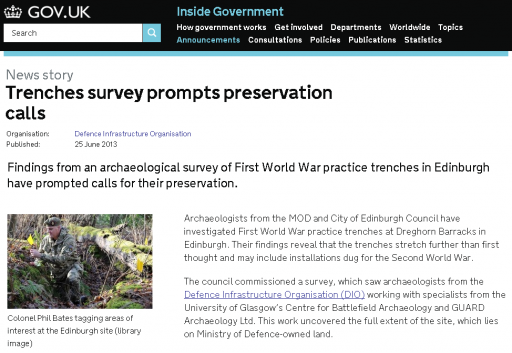Archaeologists from the British Ministry of Defence and the City of Edinburgh Council have surveyed the First World War Dreghorn Trenches in Edinburgh, Scotland.
The Dreghorn Trenches were used in training for British troops before they departed for the Western Front during the First World War.
The Defence Infrastructure Organisation (DIO) worked alongside specialists from the University of Glasgow’s Centre for Battlefield Archaeology and GUARD Archaeology Ltd. in conducting the survey.
This work uncovered the “full extent of the site”, which lies on Ministry of Defence-owned land.
DIO Environmental Adviser Phil Abramson said:
“The survey has shown that considering some of the trenches have been open for 100 years they are in remarkably good condition but that they are vulnerable to several threats including soil erosion, scrub growth and damage from tree throws”.
The survey makes a number of recommendations for further work on the best preserved sections of the trenches, as part of a wider five year woodland management plan, which the DIO recently agreed with the council.
Suggestions for further work on the trenches include:
Removal of trees and shrubs which may cause further damage to the trenches.
Installation of interpretation panels to explain the trenches’ history to the public.
Further research and limited excavation to better understand these important monuments.
The creation of educational material for schools.
Councillor Richard Lewis, Edinburgh Council’s Culture and Sport Convener stated:
“This is an important moment in the preservation of the Dreghorn trenches. The Council has a duty to protect Edinburgh’s rich cultural heritage, and we are keen to work with our partners going forward to establish our next steps”.
“With the centenary of the First World War coming up next year, preserving these trenches takes on a special significance. Saving them for future generations will help us all remember the thousands of Scots soldiers that lost their life in battle”.
Date of press release publication: 25/06/2013
Images courtesy of the Inside Government UK website
Source: Inside Government UK wesbite
Posted by: Daniel Barry, Centenary News
